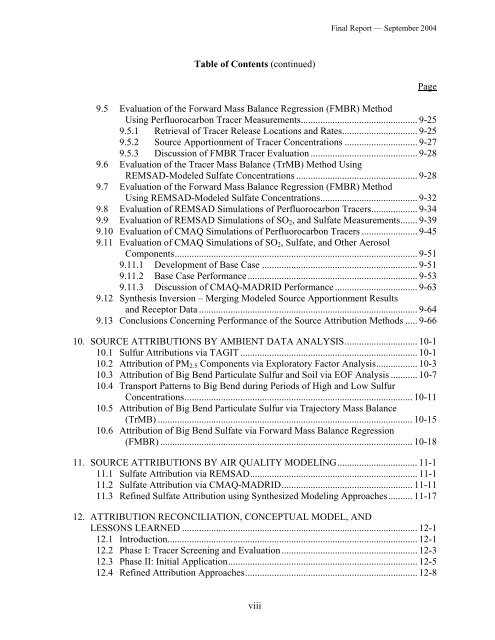(BRAVO) Study: Final Report. - Desert Research Institute
(BRAVO) Study: Final Report. - Desert Research Institute
(BRAVO) Study: Final Report. - Desert Research Institute
You also want an ePaper? Increase the reach of your titles
YUMPU automatically turns print PDFs into web optimized ePapers that Google loves.
<strong>Final</strong> <strong>Report</strong> — September 2004<br />
Table of Contents (continued)<br />
Page<br />
9.5 Evaluation of the Forward Mass Balance Regression (FMBR) Method<br />
Using Perfluorocarbon Tracer Measurements................................................ 9-25<br />
9.5.1 Retrieval of Tracer Release Locations and Rates............................... 9-25<br />
9.5.2 Source Apportionment of Tracer Concentrations .............................. 9-27<br />
9.5.3 Discussion of FMBR Tracer Evaluation ............................................ 9-28<br />
9.6 Evaluation of the Tracer Mass Balance (TrMB) Method Using<br />
REMSAD-Modeled Sulfate Concentrations .................................................. 9-28<br />
9.7 Evaluation of the Forward Mass Balance Regression (FMBR) Method<br />
Using REMSAD-Modeled Sulfate Concentrations........................................ 9-32<br />
9.8 Evaluation of REMSAD Simulations of Perfluorocarbon Tracers................... 9-34<br />
9.9 Evaluation of REMSAD Simulations of SO 2 , and Sulfate Measurements....... 9-39<br />
9.10 Evaluation of CMAQ Simulations of Perfluorocarbon Tracers ....................... 9-45<br />
9.11 Evaluation of CMAQ Simulations of SO 2 , Sulfate, and Other Aerosol<br />
Components.................................................................................................... 9-51<br />
9.11.1 Development of Base Case ................................................................ 9-51<br />
9.11.2 Base Case Performance...................................................................... 9-53<br />
9.11.3 Discussion of CMAQ-MADRID Performance .................................. 9-63<br />
9.12 Synthesis Inversion – Merging Modeled Source Apportionment Results<br />
and Receptor Data .......................................................................................... 9-64<br />
9.13 Conclusions Concerning Performance of the Source Attribution Methods ..... 9-66<br />
10. SOURCE ATTRIBUTIONS BY AMBIENT DATA ANALYSIS.............................. 10-1<br />
10.1 Sulfur Attributions via TAGIT ......................................................................... 10-1<br />
10.2 Attribution of PM 2.5 Components via Exploratory Factor Analysis................. 10-3<br />
10.3 Attribution of Big Bend Particulate Sulfur and Soil via EOF Analysis ........... 10-7<br />
10.4 Transport Patterns to Big Bend during Periods of High and Low Sulfur<br />
Concentrations.............................................................................................. 10-11<br />
10.5 Attribution of Big Bend Particulate Sulfur via Trajectory Mass Balance<br />
(TrMB) ......................................................................................................... 10-15<br />
10.6 Attribution of Big Bend Sulfate via Forward Mass Balance Regression<br />
(FMBR) ........................................................................................................ 10-18<br />
11. SOURCE ATTRIBUTIONS BY AIR QUALITY MODELING................................. 11-1<br />
11.1 Sulfate Attribution via REMSAD..................................................................... 11-1<br />
11.2 Sulfate Attribution via CMAQ-MADRID...................................................... 11-11<br />
11.3 Refined Sulfate Attribution using Synthesized Modeling Approaches.......... 11-17<br />
12. ATTRIBUTION RECONCILIATION, CONCEPTUAL MODEL, AND<br />
LESSONS LEARNED ................................................................................................. 12-1<br />
12.1 Introduction....................................................................................................... 12-1<br />
12.2 Phase I: Tracer Screening and Evaluation........................................................ 12-3<br />
12.3 Phase II: Initial Application.............................................................................. 12-5<br />
12.4 Refined Attribution Approaches....................................................................... 12-8<br />
viii
















